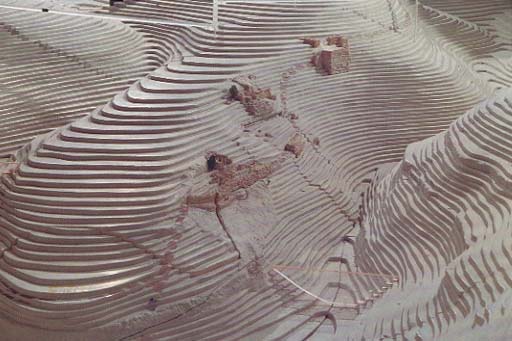Image Details

Zev Radovan
Jerusalem as it was. Topographic contour lines—each equivalent to six feet—ripple like a windswept sand-dune above. This portion of a 15-by-21-foot model recreates the bedrock of the City of David and the Ophel ridge and displays several archaeological discoveries from the First Temple period. In the area bounded by the deep Kidron Valley, at right, and the shallower valley, upper left, we see archaeological remains just as they were found. Three groups of remains can be seen. The uppermost group is the gate complex excavated by Eilat Mazar. Built in the 9th century B.C., the complex is now identified with the Water Gate mentioned by Nehemiah (Nehemiah 3:26). This gate, on the northern Ophel ridge, may have given access to the royal precincts located between the Temple Mount to the north and the City of David to the south. The broken red line on either side of the gate marks the presumed location of the city’s 8th century B.C. protective wall, two portions of which have been recovered. These two portions can be seen in the lowest of the three groups of remains in the picture. In the middle group of remains is the House of Ahiel, so-called because of the name found on a pottery sherd inside it. This and the neighboring houses in the middle group of remains were built into a massive stepped stone structure (visible above and to the right of the tree). This stepped-stone structure may have been a retaining wall for a platform supporting a large public building or the substructure for a citadel. At lower left, above the city wall remains, we see the pillars of the Ashlar House, named after the carefully dressed stones with which it was built.
For comparison, see photograph of the same area as it appears today.
